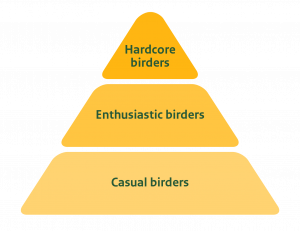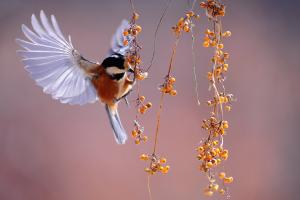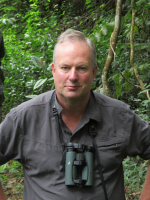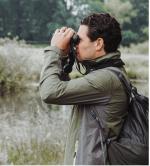
The European market potential for birdwatching tourism
Birdwatching is becoming increasingly popular among European tourists. The United Kingdom is the largest European source country for birdwatching tourism, followed by the Netherlands and Germany. Birdwatching tourism attracts experienced travellers and offers spacious destinations. Therefore, the expectation is that this niche market will recover relatively fast when COVID-19 restrictions decrease. Birdwatching offers many opportunities, including younger travellers becoming more interested and the increased possibilities for marketing efforts on social media and other internet platforms.
Contents of this page
1. Product description
Birdwatching tourism or “avitourism” refers to travel where the main purpose is to observe birds in their natural habitat. Birdwatching, or “birding’’, refers to finding, observing, and identifying birds for educational and enjoyment purposes. It is very much related to nature tourism and adventure tourism. Therefore, many tour operators offering birdwatching tourism also offer nature and adventure-based trips. Birdwatching tourism is divided into three specialist niches: casual birding, enthusiastic birding, and hardcore birding.
Table 1: Specialist niches with example tour operators
| Specialist niche | Example |
| Casual birding | Robin Pope Safaris is a tour operator in Zambia, Malawi and Zimbabwe that offers walking, camping, and underwater safaris, and that often includes birdwatching in their group tours and family safari tours. |
| Enthusiastic birding | Venture Uganda is a tour operator that offers extensive birdwatching safaris. Next to that, they also offer other birdwatching tour packages that include cultural, nature and adventure activities. |
| Hardcore birding | Myanmar Birding Tours offers tours exclusively for birdwatchers. They provide a variety of birdwatching tours, depending on the birds you want to see. |
Activitis catered to casual and enthusiastic birders are more accessible to offer for tour operators, because casual and enthusiastic birders have a wider range of interest than birding alone and are less specific in their demands. Hardcore birders are very knowledgeable and have very specific demands, especially about the birds they want to see.
Tips:
- Read the CBI studies on nature tourism, adventure tourism, and wildlife tourism.
- Inform yourself on the niches available in tourism to be able to make a clear choice. CBI offers an infographic which gives a clear overview on all segments and niche markets in tourism.
2. What makes Europe an interesting market for birdwatching tourism?
Globally, around three million international trips are dedicated to birdwatching every year. Birdwatching tourism has been a rapidly growing market, with the largest share coming from Europe. At least 20% of European travellers that engage in wildlife tourism are interested in birdwatching activities as well. Birdwatching is a popular hobby among Europeans, and this birdwatching tourism is expected to increase when travel restrictions due to COVID-19 are lifted.
Already 37% of all European tour operators offer birdwatching tourism for casual birders. Although the birdwatching market is growing, most tour operators in Europe consider birdwatching tourism as a sub-category of wildlife tourism. Most tour operators do not provide trips dedicated to birding specifically, but consider birdwatching as a potential activity. European tour operators that provide birdwatching activities usually include them in wildlife tourism or ecotourism trips.
Africa and the United States are popular destinations for European birdwatchers. Asia and South America are relatively new destinations for birdwatchers, but are experiencing rapid growth. While most European birdwatchers go on organised tours, there are also birdwatchers that plan their own trip without a tour operator.
COVID-19 travel restrictions and safety measures
Due to COVID-19 travel restrictions, the tourism industry has decreased tremendously. Because birdwatching tourism uses spacious destinations, it is expected to recover relatively fast. When travel restrictions are lifted, European tourists are likely to travel to destinations that feel safest in regard to COVID-19. For example, small chalets in national parks are preferred over hotels and large group accommodations.
Europeans with a medium to high income are expected to travel first as travel restrictions are lifted. Birdwatchers have engaged more in solo birding, or birding with their spouse during the COVID-19 pandemic. They might want to travel in smaller groups or alone at first when the travel restrictions are lifted.
Technological tools and platforms
Apps, birdwatching platforms like fatbirder.com, eBird, and social media platforms like TripAdvisor and Instagram are becoming increasingly important, especially among younger tourists. Good reviews and bird sightings on these platforms are key when you want to attract birdwatching tourists. Birding tourists use these tools for travel destination inspiration. They are also influenced by friends and family they follow on social media. Fatbirder, eBird and social media are platforms where people can inform themselves on recent bird sightings and get inspiration on travel destinations.
Political circumstances and current affairs in destination countries
Europeans are very aware of current affairs in various countries because they have easy access to the internet to attain this information. Tourists are less likely to visit a country with unstable political circumstances or recent disastrous events. Make sure to consult the source country’s advice on their inhabitants travelling to your country. Relevant examples include the pages for the Dutch, UK, Swedish, or German Ministries of Foreign Affairs.
Tips:
- Read our study on trends in the European tourism market to learn about trends that are affecting tourism and how to adjust to meet current demands.
- Read our study about managing the effects of COVID-19 on the tourism industry to find out about reliable sources about Europe’s COVID-19 situation. Read the study about how to respond to COVID-19 to learn about a step-by-step plan that can help you respond and recover from the effects of COVID-19. Also see the World Health Organization’s COVID-19 dashboard to keep up-to-date on the current number of COVID cases. Travel restrictions are likely to be reduced when the infection rates in target countries decrease.
- Inform your potential clients of the safety measurements taken. Many birdwatchers are elderly people who have an increased risk of health issues. Although the elderly will be vaccinated by the time travel restrictions are lifted, the expectation is that hygiene, and health and safety concerns will remain key.
- Europeans prefer organised package holidays when travelling to politically unstable countries. Make sure that guides can take care of the tourists’ safety and put effort in gaining tourists’ trust.
Market segmentation
The average birder is 50 years old, well-educated, and sustainably aware. Older, retired birders often have more time and money to go birding. Most birdwatchers are men. Women usually get involved with birdwatching because of social groups or organised activities involving birdwatching. The European birdwatcher spends on average around 100 euros a day and spends several nights at one destination.
Although older birders still make up the most important target group, the market is slowly changing. More millennials are becoming interested in birdwatching tourism. This is partly due to their increasing awareness of sustainability issues, especially concerning the importance of biodiversity across generations.
As casual birders, enthusiastic birders and hardcore birders all have different demands, it is important to make a clear decision as to which target group you will focus on.
Casual birders are birders that enjoy watching birds, however, it is not their primary goal for travel. They enjoy seeing other wildlife and taking part in cultural and social activities as well. These birders tend to book their travels through tour operators. Their packaged holidays often include tours to watch other wildlife, and they require some encouragement to undertake birding activities. Casual birders are the largest specialist niche within birdwatching. They are generally both men and women.
Enthusiastic birders seek out birds for educational and conservational purposes. These birders are sustainably aware and care about the conservation of birds. On average, enthusiastic and casual birders are 55 years old, but many birdwatchers from generation Y and generation Z fall within these specialist niches too. Enthusiastic birders are also interested in side activities besides birding, such as activities that involve wildlife watching like safaris. Together with casual birders, they are usually nature enthusiasts and, in some cases, might have a professional interest.
Hardcore birders travel for the sole purpose of finding birds, or particular bird species. These birders are very knowledgeable and keep track of the number and species of birds they have observed over time, keeping lists where they check off birds they see. These birders often seek out a specific destination according to a specific bird species’ habitat, sometimes because they want to observe an bird they have not yet checked off their list. They have more advanced equipment, such as high-end binoculars, good-quality cameras, or audio recorders to record bird sounds.
The birders in this segment are usually male baby boomers who either travel alone or with their partner. These birders usually prefer a private or small-group tour with a knowledgeable guide. They like to get up early, as dawn and dusk form the ideal time slots for birdwatching. Some of these birders may have a background in ornithology, the study of birds. Hardcore birders care less for high-end accommodation and will be satisfied with basic accommodation, because their main purpose is to go birdwatching. Hardcore birders are mostly men.
Enthusiastic and hardcore birders are often involved with national or international bird conservation organisations, such as the Dutch ‘Vogelbescherming’, the British ‘Royal Society for the Protection of Birds’ , and the international ‘Bird Life International’. These birders often visit bird fairs in their own country, such as the British Bird Fair. Hardcore birders, and some enthusiastic birders travel at different times of the year to see seasonal birds at the destination.
Figure 1: The specialist niches in birdwatching tourism

Besides the segmentation into casual, enthusiastic and hardcore birders, there is a difference between listers and photographers (although many birdwatchers will not fall in either category because they have a more general interest).
Listers aim to see all the birds on their list during their lifetime. Such a list mostly contains birds from all over the world (if so, they are also called world listers). Listers travel to destinations where they know birds on their list have been spotted before. They are mostly hardcore birders and are interested in seeing rare birds in their natural habitat.
They are well-prepared and have a lot of knowledge on the birds they are interested in. Because they are mainly interested in a few birds, they have very specific demands. Listers are also called ‘twitchers’ but many will be annoyed if called so and prefer the more general term ‘birdwatcher’.
Photographers are birders who mainly aim to photograph birds. Their main interest is to get a good photo of their bird of choice, and they are less interested in information about the birds or their habitat. Many photographers like to lure birds with food to take a nice picture from a short distance, which is a no-go for many listers, who prefer to see birds in their natural environment.
Figure 2: bird lured with food

Source: Pexels
Sometimes photographers are called ‘toggers’, both in a neutral and in a derogatory way. Therefore, it is best to avoid this term. Many photographers travel with a European tour operator. BirdQuest and Rockjumper are examples of tour operators targeting photographers.
Listers and photographers can best be put in different tour groups, as their interests are very different.
Tips:
- Get in touch with local bird clubs and magazines in European source countries to advertise. Examples of local bird clubs are the British Birdspot magazine , the Dutch Vogelbescherming magazine, the Swedish STOF magazine, and the Spanish La Chiricoca
- Get in touch with other local tour operators to collaborate on setting up activities besides birdwatching, for enthusiastic and casual birders. This way you can provide a truly unique experience for birding tourists. Mountain biking, kayaking, or driving safaris, or setting up a campfire and roasting marshmallows are examples of such activities.
- Make all activities for hardcore birdwatchers secondary to birdwatching. Offer dusk and dawn tours so they have a higher chance to spot the birds they came for. Flexibility around mealtimes is also important, as watching birds always is the top priority. Make birdwatching your specialisation, because this target group is not interested in side activities. Put your effort into high-quality birdwatching tours and information, instead of high-end accommodation or side activities
- Set up hides to accommodate photographers in their efforts to take good shots.
- Provide information on which birds tourists can find at your destination, and include it in your marketing strategy. Posting it on your website and social media, or presenting it at bird fairs will show potential tourists what makes your destination stand out. Some (hardcore) birders will travel very far to see unique species, but casual and enthusiastic birders will find rare species most interesting as well.
3. Which European countries offer most opportunities for birdwatching tourism?
The most important European source markets for birdwatching tourism in terms of market size are the United Kingdom, the Netherlands, Germany and Sweden. Many birdwatchers in these countries are involved in local or national bird conservation organisations. Italy, Spain, and Portugal are also European source markets for birdwatching tourism, but far less so than the first-mentioned countries in terms of market size.
The preferences per European country for birdwatching tourism are similar across the most important source countries, especially for hardcore birders. Most birdwatchers from the top 4 European source countries speak English well.
The United Kingdom
The United Kingdom is by far the biggest European source market for birdwatching. Many British people are interested in birdwatching and their number continues to increase every year. The Royal Society for the Protection of Birds is the biggest national bird organisation, with around one million members. Of all European countries, the United Kingdom has the highest number of tour operators that organise birdwatching trips.
The United Kingdom also has the highest number of birders of all types: casual, enthusiastic, and hardcore. Many Brits go outdoors to see birds or feed the birds that come into their garden. This means that birdwatching activities might be interesting for them when travelling internationally as well. Most British birdwatchers book with a tour operator from the United Kingdom.
In 2020, the average holiday budget in the UK €2,108, which is very high compared to the other European countries.
The Netherlands
Just like most UK birdwatchers, most birdwatchers in the Netherlands are also interested in nature and other wildlife besides birdwatching. The Netherlands has a relatively large number of birdwatchers who keep a list of the birds they aim to spot. De Vogelbescherming is a bird conservation organisation with 140,000 members in the Netherlands.
In general, Dutch tourists generally prefer active holidays that allow them to enjoy birdwatching and also be physically active. Although they have generous budgets, they are generally considered price-conscious. Their communication style is very direct. Dutch tourists are often good English speakers, and some speak German and French as well.
Germany
Germans usually go on organised trips and prepare well before their travels. They generally book their trips online. Although they prefer less active holidays in comparison to the Dutch, many will enjoy hiking in nature. German tourists generally do not like uncertainty. They tend to read a lot before visiting a place and are, like most Europeans, quite direct in their communication.
Germans are dedicated travellers and enjoy going on holidays a lot. Out of all European tourists, Germans spend the most money during international travel. 74% of Germans go abroad for holidays and over 50% of German travellers book activities through a tour operator or online travel agency.
German tourists enjoy spending their holidays in warm and sunny countries. In 2018, 5% of German international travellers travelled to Africa for their holidays, while 25% travelled to Asia or the Asia Pacific region and 15% travelled to the Americas. The average German budget for international travel in 2020 was €1,583 per trip.
BirdLife’s German partner Naturschutzbund Deutschland (NABU) was originally founded as a bird conservation organisation but has since broadened its scope to wildlife more generally. It has 445,000 members.
Sweden
Swedish birdwatchers are especially interested in birdwatching on an academic level, as their educational standards are high and that often reflects on their personal interests as well. As such, their demand for educational tours and services while birdwatching is likely to be high. BirdLife Sweden is the national bird conservation organisation and has around 16,600 members.
Italy and Spain
Italy and Spain are important birdwatching destinations, which has stimulated birdwatching as a hobby for people in these countries. Spanish and Italian birdwatching guides also look for more knowledge and sometimes travel to other countries to do birdwatching. The Italian Lipu and the Spanish SEO Birdlife are the respective birdwatching conservation organisations.
Italian and Spanish tourists mostly book their trips via tour operators instead of online, compared to tourists from the other countries in the top 6. Also, they have a higher preference for information in their own language, because they often don’t speak English as well.
* The German NABU also has members interested in different wildlife
Tips:
- Target the United Kingdom via British tour operators if your aim is to enter the largest European source market for birdwatching tourism, especially if there is little competition at your destination. As (especially hardcore) birders are experienced travellers, they will be willing to travel to your destination if it offers interesting bird species.
- Target specialised European tour operators with a clear and appealing offering. Fatbirder offers a list of tour operators offering birdwatching tours. Also consult our tips for doing business with European tourism buyers to read about how to contact European buyers.
- Make sure there are no language and spelling errors in the English text on your website and social media. European tourists find it easier to trust tour operators that provide information in correct English. Get in touch with a native speaker for professional English translations. French translation is also important when targeting French tourists, because French tourists generally prefer to read and speak French.
- Provide a list of translated bird names for birders that are not familiar with the bird names in English or your native language. Most Europeans speak English well, but their knowledge of bird names might be limited. This is especially true for casual birders.
- Get in touch with European birders and local guides knowledgeable about birds to set up an effective way of marketing your tours, for example via LinkedIn. Enthusiastic and hardcore birders are mostly very loyal and tend to stick with the same tour operators or guides.
4. Which trends offer opportunities in the European birdwatching tourism market?
Younger travellers engage in birding
Birdwatchers are usually elderly people, but the age range of birders is getting broader. Adults, younger adults, and sometimes children are becoming more interested in birdwatching and their number is going to increase in the years to come. As a result, the market is changing. Younger generations are often inspired by online sources, and care more about sustainable choices and biodiversity.
Because they are fitter and generally care more about their health, younger birders also like to be physically active. Therefore, trips including longer hikes are more interesting for this target group. Just like hardcore birders, generations Y and Z care less about luxurious accommodations. More information about this and other trends can be found in our study on trends in tourism.
Birders use online tools for birding
The use of online tools is becoming more and more popular, both before and during travel. Fatbirder offers a huge amount of information on birdwatching, birding and bird travel worldwide. Another popular website is eBird, which is a website where bird sightings can be recorded. This contributes to conservation decisions and academic research related to birds and their environment.
eBird also shows birders interested in travelling internationally where to spot specific bird species. They can look up recent sightings and this can determine their travel destination. Local tour operators can communicate local sightings to birdwatchers on this platform. eBird is especially interesting for hardcore birders. It also has an app-version with lists for birders to use when travelling to a specific destination.
There are more apps available designed for birding. For instance, apps to keep track of lists (Bird Journal), identifying birds through pictures or sounds (Merlin Bird ID), or bird finding guides that help birders find local or rare birds (BirdsEye Hotspot).
Photographing birds is becoming more popular
Wildlife and birdwatching photography have become increasingly popular among tourists. This trend is largely driven by the decreased prices of high-quality cameras. Taking pictures of birds has become a trend within birdwatching tourism specifically. Tropical Birding is a tour operator that organises various ‘Birding with camera’ tours specifically for birdwatchers interested in getting the perfect picture.
Birdwatchers care about sustainable birdwatching
European birdwatchers care about preserving the natural habitat of the birds they want to see. Deliberately causing birds to fly away (flushing) is definitely a no-go for most Europeans. Observing nature without interfering with the bird or its habitat is one of the Ethical Birdwatching Guidelines.
Therefore, managing the natural environment to accommodate the birds is important. Providing safe nesting areas is an example of how to make sure birds feel safe and stay. Making sure domesticated animals, like cats, do not try and catch the birds is also important.
Also, they find it important that the money they spend at their destination gets reinvested in local communities and the conservation of the local environment. That way, they feel that they are contributing to the economy and social welfare of the local communities and help to preserve the environment.
Sam Veasna Conservation Tours is an example of public/private collaboration where the local indigenous community manages birdwatching tourism and supports breeding of endangered birds. In return, they receive government funding to uphold their activities and sustain themselves.
Nurgi Birding Ethiopia provides packaged and personal birdwatching trips with knowledgeable guides in Ethiopia. Part of the money they generate from tourism gets reinvested in conserving the Abyssinian Woodpecker.
Tip:
- Learn about the opportunities in the European tourism market for Generation Y travel if you are still mainly targeting baby boomers and looking for opportunities for growth.
Get in touch with local wildlife organisations to ask for their expertise on how to manage the animals’ habitat in a sustainable way while also taking the wishes of tourists into account. African Bird Club is a bird conservation organisation that promotes conservation, provides resources and is interested in promoting similar regional initiatives. Oriental Birdclub does the same in the Southeast Asia region. Neotropical Birdclub does this for the whole South and Middle America region and the Caribbean.
Share bird names that you or tourists have spotted while on tour with you. This way birders know what they can expect on your tours. It is also important, however, to manage tourists’ expectations by communicating with them that birds will not always show themselves.
Educate birders to not feed, touch or harm the birds by, for example, turning on the camera flash. Making sure birds can be photographed without their habitat being disturbed is key.
This study was carried out on behalf of CBI by Molgo and ETFI.
Please review our market information disclaimer.
Search
Enter search terms to find market research

